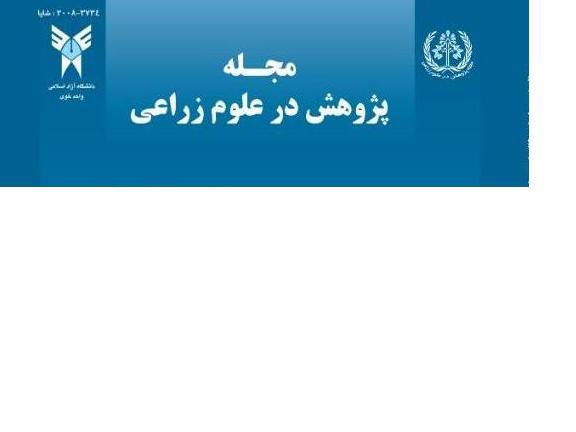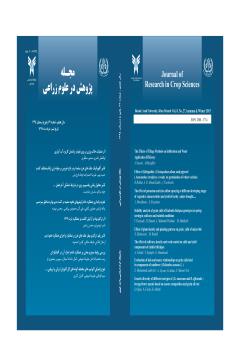بررسی روابط منبع و مخزن بر عملکرد دانه و اجزاء آن در آفتابگردان
محورهای موضوعی : توليد محصولات زراعيزينب محمدزاده اصل 1 , عليرضا عيوضي 2
1 - دانش آموخته كارشناسي ارشد، گروه كشاورزي – زراعت، دانشگاه پيام نور البرز، كرج – ايران.
2 - استاديار پژوهشي بخش تحقيقات نهال و بذر، مركز تحقيقات و آموزش كشاورزي و منابع طبيعي استان آذربايجانغربي، سازمان تحقيقات، آموزش و ترويج كشاورزي، اروميه – ايران
کلید واژه: آفتابگردان, حذف برگ و دانه, عملکرد دانه و اجزای آن.,
چکیده مقاله :
جهت بررسی اثر سطوح مختلف حذف برگ و دانه بر عملکرد دانه و اجزای آن در آفتابگردان آجیلی، آزمایشی در ایستگاه تحقیقات کشاورزی ساعتلوی ارومیه اجرا گردید. این آزمایش به صورت فاکتوریل در قالب طرح بلوک های کامل تصادفی در چهار تکرار در بهار 1391 انجام شد. فاکتور اول حذف برگ در چهار سطح شامل، عدم حذف برگ، حذف برگ های 3/1 فوقانی ساقه، حذف برگ های 3/1 میانی ساقه، حذف برگ های 3/1 تحتانی ساقه بود. فاکتور دوم حذف دانه در چهار سطح شامل، عدم حذف دانه، حذف دانه های 3/1 کناری طبق، حذف دانه های 3/1 میانی طبق، حذف دانه های 3/1 مرکزی طبق بود. نتایج نشان داد که تیمار عدم حذف برگ و حذف 3/1 دانه های کناری بیشترین تاثیر را روی وزن هزار دانه به میزان 250/223 گرم و ماده خشک کل بوته به میزان 2656 گرم داشت. هم چنین بیشترین عملکرد دانه در هر طبق به میزان 50/177 گرم مربوط به تیمار حذف برگهای 3/1 تحتانی و عدم حذف دانه بود. در تیمار عدم حذف برگ صفت مساحت برگ با ماده خشک کل همبستگی مثبت و معنی داری وجود داشت (r=0.99**). در تیمار عدم حذف دانه صفت درصد پروتئین دانه با عملکرد دانه همبستگی مثبت و معنی داری (r=0.96*) داشت. دو صفت مساحت برگ و قطر طبق بیشترین تاثیر را بر عملکرد دانه داشته و در مدل رگرسیونی حذف برگ باقی ماندند. در تجزیه رگرسیون حذف دانه، صفت قطر دانه بیشترین تاثیر را بر عملکرد دانه داشت.
To investigate the effects of different levels of leaf and grain removing on grain yield and its components in sunflower, an experiment was carried out in Saatloo agricultural research station of Urmia. A factorial experiment was done based on randomized complete blocks design with four replications in 2012 growing season. The first factor consisted of four levels of defoliation including; removing 1/3 upper, removing 1/3 middle, removing 1/3 lower leaves of stem and no defoliation of control. The second factor involved grain removing with four levels; removing 1/3 of side, 1/3 of middle and 1/3 of central grains of disc flower and non grain removing as control. Results showed that non-leaf removing and removing 1/3 side grains of disc flower had the highest effect on 1000 kernel weight with 223.25g and total dry matter 2656.0g/plant. The highest amount of grain yield was 177.50g/plant in removing of 1/3 below leaves and non removing grains. In non leaf removing treatment, leaf area had significantly positive correlation with total dry matter ( r=0.99**). Also, protein grain percentage had positively significant with grain yield in non grain removing of disc flower ( r=0.96*).Regression analysis showed that traits of leaf area and disc flower diameter in leaf removing treatment and only disc flower diameter in grain removing treatment had the greatest effects on grain yield.
Abbaspoor, F., M. R. Shakiba, H. Aliyari, and Valizade, M. 2006. Effect of leaf removal in the beginning of pollination based on oil yield and its components in two sunflower cultivars. Journal of Agricultural Knowledge.59: 1-7. (In Persian).
Abdi, S., A. Moghaddam, and Ghadimzadeh, M. 2007. Effect of defoliation intensity in different reproductive stages of two Sunflower (Helianthus annus L.) cultivars on grain and oil yield. Journal of Agricultural Science and Natural Resources. 11(40): 245-255.
Abdi, S., A. G. Moghadam, and Ghadimzadeh, M. 2008. The effect of different levels of leaf removal in plant production stages on seed yield and oil content of two hybrids of sunflower. Journal of Agricultural Science and Technology. 40: 245-255. (In Persian).
Erbas, S., and Baydar, H. 2007. Defoliation effects on seed yield and oil quality of sunflower (Helianthus annuus L.). Turkish Journal of Biology. 43: 115-118.
Jamshidi, A., M. Aghaalikhani, and Ghalavand, A. 2008. Effect of leaf removal severity in different growth stages on grain and oil yield of sunflower. Iranian Journal of Crop Sciences. 4: 349-361. (In Persian).
Johnson, B. L. 1972. Effect of artificial defoliation of sunflower on grain yield and other characteristics. Agronomy Journal. 64: 688-689.
Leon, A., F. Andrade, and Lee, M. 2003. Genetic analysis of seed-oil concentration across generations and environments in sunflower. Crop Science. 43: 135-140.
López Pereira, M., N. Trápani, and Sadras, V. O. 1999. Genetic improvement of sunflower in Argentina between 1930 and 1995 II. Phonological development, growth and source–sink relationship. Field Crops Research. 63(3): 247-254.
Muro, J., I. Irigoyen, A. F. Militino, and Lamsfus, C. 2001. Defoliation effects on sunflower yield reduction. Agronomy Journal. 93: 634-637.
Nakhlawy, F. S. 1993. Defoliation effects on grain yield, yield components and quality of sunflower. Alex Journal of Agricultural Research. 38: 257-267.
Schneiter, A., and Johnson, B. L. 1994. Response of sunflower plants to physical injury. Canadian Journal of Plant Science. 74: 763-766.
Singh, A., and Khan, A. H. 1987. Defoliation and yield efficiency in sunflower. National Academy Science. 21: 311-312.
Siosemarde, A., H. Ranjbar-Balkhkanloo, Y. Sohrabi, and Bahramnejad, B. 2009. The effect of drought stress and source reservoir constraints on gas exchange and grain yield of sunflower. Iranian Journal of Crop Sciences. 6: 3-4. (In Persian).

